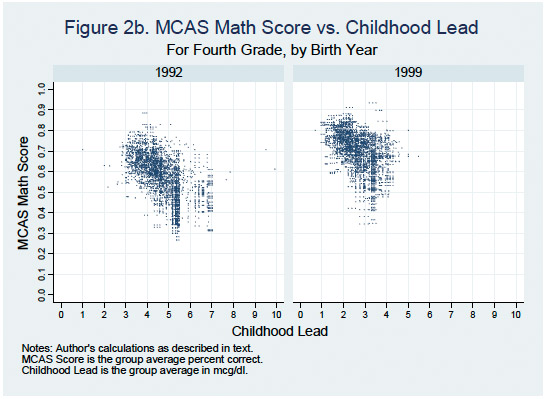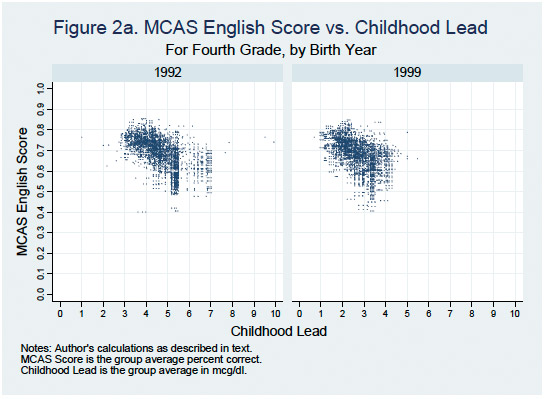One of the more subtle factors in student achievement—so subtle it rarely gets mentioned anymore—is the pernicious effects of lead exposure, something I've taken an interest in before. So I was encouraged to see a recent study floating around the blogosphere, which links lead abatement to increased student performance, comparable to tremendous increases in median income. It's an examination of lead abatement in Massachusetts, where substantial work has been done over the last few decades in reducing early childhood lead exposure, and its effect on the schools—which are quite high achieving, particularly in the realm of testing, allowing Mitt Romney to plausibly claim that its schools are the best in the country.
The author, Jessica Wolpaw Reyes, found that the state's lead-abatement efforts not only boosted school performance, they also closed the achievement gap between low-income students and their peers. Graphed, the results are subtle, but you can see how the tail-end came up as lead levels declined.


Translated:
From this first look, it is clear that higher lead levels are associated with lower test scores. It is also apparent that this effect is stronger for Math than for English, and that it is stronger in the
early cohort than in the later cohort. Lastly, we see that, as lead levels declined, test scores also rose, and that the entire distribution moved towards markedly lower lead and somewhat higher scores.
The results were more substantial among schools with larger decreases in lead exposure:
[T]he share of children scoring unsatisfactory on the 4th grade Math MCAS declined by 4.7 percentage points more in schools with above‐average lead declines (relative to schools with below‐average lead declines), and 6.5 percentage points more in schools with top‐quartile lead declines (relative to schools with bottom‐quartile lead declines.)
And even at a statewide level, the differences are significant:
Applying the main results from Section 6.4, the 8.2 percentage point decline in the share of Massachusetts children with blood lead above 10 μg/dL would produce a decline of 1.7 percentage points in the share of children scoring unsatisfactory on the MCAS. This improvement, when compared to the base rate of 30‐35 percent of children scoring unsatisfactory, amounts to an approximate 5% reduction in unsatisfactory performance statewide.
Wolpaw Reyes compares this to how much you'd have to raise incomes, statistically speaking, among low-income students to achieve similiar effects; her estimate is $2,200 per capita, raising 5.4 percent of students out of the low-income bracket, a substantial increase (emphasis hers): "to get, without the decline in lead, the same test score performance that was seen at the end of the period, per‐capita income would have had to go up by 15% for low income communities."
It's not the first time Wolpaw Reyes has written compelling stuff on lead and its effects. Her 2007 paper "Environmental Policy as Social Policy? The Impact of Childhood Lead Exposure on Crime" (PDF) takes a longer look, and comes to a jaw-dropping conclusion (emphasis mine):
This paper argues that the removal of lead from gasoline in the late 1970s under the Clean Air Act is an additional important factor in explaining the decline in crime in the 1990s. The main result of the paper is that changes in childhood lead exposure are responsible for a 56% drop in violent crime in the 1990s.
Wolpaw Reyes's most recent paper looks at Massachusetts, but another 2012 paper, by seven academics at the University of Wisconsin-Madison, examines similar effects in Milwaukee—like Chicago, another Rust Belt city struggling with segregation, poverty, and educational inequality. (Upper Midwestern cities tend to have greater problems with lead exposure, and Milwaukee has the highest levels of elevated lead exposure of any city in Wisconsin.) Among the students the authors studied, they found that 71 percent had "moderate" lead exposure and 29 percent had no exposure (technically, below the offical state levels of quanitification and the current CDC reference level). The breakdowns are pretty dramatic:
* Qualified for assisted lunch: 77 percent exposed, 23 percent unexposed
* Black/Hispanic/white by exposure: 80 percent, 64 percent, 38 percent
* Special-education and non-special ed exposure: 81 percent, 68 percent
* Suspension incidents: suspended in 4th grade, 88 percent exposed; not suspended, 66 percent exposed
Yes, poverty correlates with both exposure to lead and school performance. But the authors controlled for various differences—poverty, race, attendance, suspensions—and still found effects on school testing. As in Massachusetts, the effects were larger in math: "equivalent to 22% of the interval between categorization as 'proficient' or 'basic' in reading, and 42% of the interval in mathematics." And like Wolpaw Reyes, the authors conclude that lead abatement is not merely an effective way to improve test scores, but perhaps the most straightforward one as well.
That lead abatement has taken place in paint and in gas, and lead exposure has dropped dramatically. But it's still out there, particularly in the water. Cities have been upgrading their water systems for years, in part to eliminate lead exposure, but they run into a legal barrier at the property line, since it's private property. A report by the Investigative Reporting Workshop found that replacing the public lines but not the private oens can actually increase short-term lead exposure, because a "partial replacement," in which new pipes are joined to the old private ones, can release fragments of the lead pipes into the water. It also mentions an EPA report which found significant levels of lead in Chicago water as recently as last year:
One example Edwards points to is Chicago, where the city continued to install lead pipes until 1986, when lead was banned in new plumbing and plumbing repairs. Edwards said that in 20 years of testing Chicago never produced samples exceeding the 15 parts per billion limit. From March 2011 through October 2011, however, EPA did its own tests using a few different sampling protocols, and found lead levels as high as 36.7 ppb.
Ten percent of samples above 15 parts per billion triggers the Lead and Copper Rule of 1991, which then requires the city to take action, either through corrosion control or replacing pipes. But:
In these studies, EPA conducted sequential sampling, which consists of taking multiple samples at each site, one after other, to assess the level of corrosion throughout the plumbing network. It was in these sequential samples that EPA found the high results. Currently, sequential sampling results are not allowed to be used for compliance monitoring under the current Lead and Copper Rule.
Again, you can see how poverty and lead interact: new construction doesn't have lead pipes because it was banned 25 years ago. Poor neighborhoods have older housing stock, and are more likely to have legacy lead pipes, though there's plenty of old housing stock in the city, as the Tribune found when it looked into the EPA study. But it's also public health knowledge, such as using cold water to cook and mix formula. Kevin Drum has more on water and lead.


